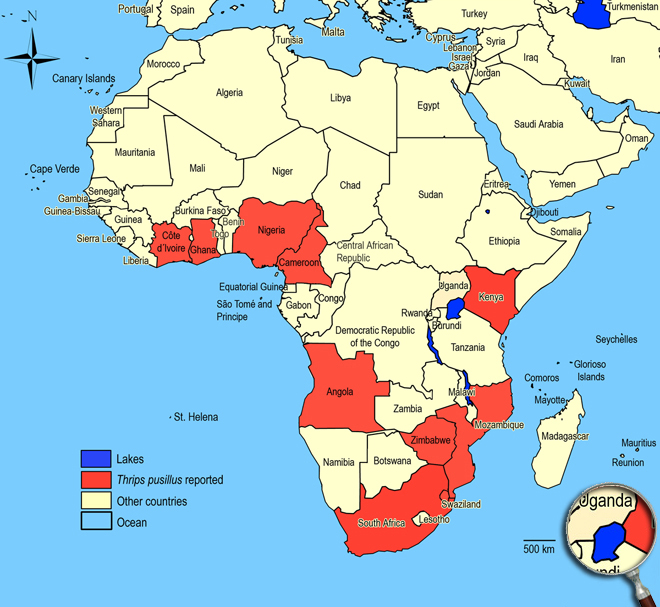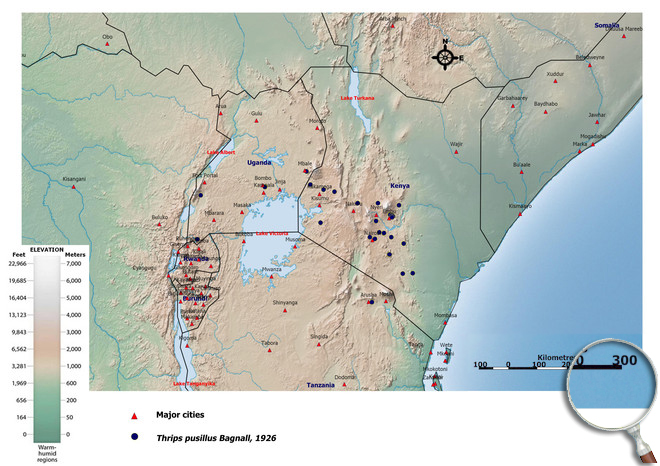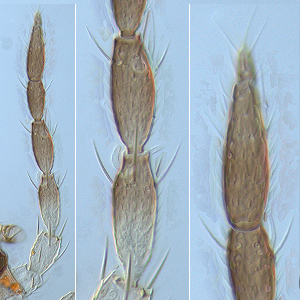Thrips pusillus Bagnall, 1926
Thripinae, Thripidae, Terebrantia, Thysanoptera
Figures
Fig. 1: 7-segmented antenna, segments III and IV with forked sense cone, terminal segments VI and VII
Fig. 2: Head dorsal with ocellar triangle
Fig. 3: Pronotum
Fig. 4: Meso- and metanotum
Fig. 5: Fore wing and fore wing middle region
Fig. 6: Sternites VI and VII
Fig. 7: Tergites IV and V
Fig. 8: Tergites VIII and IX
Fig. 9: Tergite VIII posteromarginal comb and tergite IX
Introduction and recognition
Thrips pusillus causes damage on coffee and lemon, maize and other poaceous crops, particularly in the flowers, banana fruits and other crops. Both sexes fully winged. Body and legs mainly yellow, major setae dark; tergites II-VIII with a brown median patch, IX & X usually dark; antennal segments I & II yellow, III basally yellow and distally brown, IV yellow only at base, remaining brown; fore wings weakly shaded. Antennae 7-segmented; segments III & IV slightly constricted at apex and with forked sense cone, VII short (Fig. 1). Head wider than long; with 2 pairs of ocellar setae, pair I absent, pair III small and arising usually just within or on anterior margins of ocellar triangle; postocular setae I & III of equal length, setae II minute (Fig. 2). Pronotum with 2 pairs of posteroangular setae; posterior margin with 3 pairs of setae; anterior margin with 3-4 pairs of setae (Fig. 3). Mesofurca with spinula. Metanotal sculpture lines converging to posterior margin, transverse and curving at anterior; median setae longer than lateral setae and arising behind anterior margin; campaniform sensilla absent (Fig. 4). Mid and hind tarsi 2-segmented. Fore wing first vein usually with 3 (or 2) setae on distal half; second vein with a complete row of about 15 setae; clavus with 5 marginal setae, clavus terminal seta longer than subterminal seta (Fig. 5). Tergite II with 3 or 4 lateral marginal setae; tergites V-VIII with ctenidia present laterally (Fig. 7), on VIII posteromedial to spiracles; posterior margin of VIII with complete comb of long and slender microtrichia (Fig. 8 and 9); pleurotergites without discal setae. Sternite II with 2 pairs of marginal setae, III-VII with 3 pairs, the median pair on VII arising in front of margin; sternal marginal setae about as long as a sternite; sternites without discal setae (Fig. 6).
Male similar to female but smaller.
Taxonomic identity
Species
Thrips pusillus Bagnall, 1926
Taxonomic history
Thrips meliaefloris Hood, 1932
Common name
-
Present taxonomic position
Family: Thripidae Stephens, 1829
Subfamily: Thripinae (Stephens) Karny, 1921
Genus: Thrips Linneaeus, 1758
Genus description
The genus Thrips L., 1758
There are nearly 300 species currently recognized in the genus Thrips making this genus one of the largest taxa within the order Thysanoptera. The genus was redefined progressively during the 1970's (see Mound et al. 1976), to include many species previously placed in Taeniothrips. The genus Thrips now includes a range of species, some with the antennae 7-segmented, others 8-segmented, and a few with the number of segments varying between 7 and 8. Similarly, some species have few setae on the fore wing first vein, whereas others have a complete row of setae on this vein. The species with a complete setal row on the first vein were placed from some taxonomists in the genera Isothrips or Isoneurothrips. However, all of the species in Thrips have the following character states: antennal segments III & IV with forked sense cone, absence of ocellar setae I, pronotum with 2 pairs of elongate posteroangular setae, paired ctenidia laterally on the tergites V-VIII, tergite VIII ctenidium arising posterior to the spiracle (in contrast to species of the genus Frankliniella). Other character states, such as number of antennal segments, number of setae on the fore wing veins, and number of discal setae on the abdominal sternites are variable between species (Mound & Masumoto 2005; Nakahara 1994; Palmer 1992). Identification keys are available for the species of this genus from many parts of the world. Of particular importance is the published key by Mound (2010) for members of the genus Thrips from Afro-tropical region as well as previous Lucid keys from Moritz et al. (2001, 2004 and 2009).
Species description
Typical key character states of Thrips pusillus
Coloration and body sculpture
Body color: mainly pale to yellow, or with some darker markings
Surface of head, pronotum and fore legs: without obvious or with weakly reticulate sculpture
Antennae
Number of antennal segments: 7
Antennal segment I: without any setae on dorsal apical margin
Antennal segment II: without an exceptionally long seta at the inner apex
Antennal segment II shape: symmetric
Antennal segment III shape: symmetric
Length of antennal segment III and IV: antennal segment III similar in length to segment IV
Form of sense cones on antennal segments III and IV: emergent and forked on segments III and IV
Forked sense cone on antennal segment IV: scarcely extending beyond base of segment V
Antennal segment IV and V: without a hyaline ring near the base
Antennal segment VI bears: not a remarkably dagger-shaped sensorium
Head
Distance between bases of ocellar setae III: greater than width of first ocellus
Head: not prolonged in front of compound eyes
Ocellar setae I: absent
Length of ocellar setae II: shorter than setae III
Ocellar setae III: arising within ocellar triangle anterior to tangent of anterior margin of hind ocelli (rare: arising on anterior margin of, or in front of ocellar triangle)
Ocelli: present
Length of postocular setae: not alternating short and long setae
Number of ocellar setae: 2
Prothorax
Number of pairs of anteromarginal minor setae: 3-4
Number of pairs of long anteroangular setae: 0
Number of pairs of long posteroangular setae: 2
Number of pairs of elongate pronotal setae: 2
Number of pairs of posteromarginal minor setae: 3
Pronotal blotch or internal apodeme: absent
Pronotum shape: broadly rectangular
Pronotum posteromarginal/posteroangular setae: S2 longer than S3, not equal in length
Mesothorax
Mesosternal furca: with median spinula
Metathorax
Metanotal campaniform sensilla: absent
Metanotal median setae: S1 behind anterior margin
Metanotum with dominant sculptured triangle medially: absent
Metasternal furca: without spinula
Sculpture of metanotum median area: transverse at anterior, but longitudinal and parallel on posterior half
Shape of metathoracic furca: transverse, V-shaped
Metanotal median setae length: longer than lateral metanotal setae
Wings
Fore and hind wings: present, more than half as long as abdomen (macropterous)
Fringe cilia arising: from sockets
Fore wing veins: present
Fore- and hind wing surface: covered with microtrichia
Apex of fore wing: with prominent terminal setae
Fore wing anterior margin (costal vein): with setae and cilia but cilia longer than setae
Fore wing clavus - number of marginal setae: 5
Fore wing clavus - terminal veinal seta: longer than subterminal seta
Fore wing costal fringe cilia: arising at anterior margin of wing
Fore wing first vein: distinct from costal vein
Fore wing first vein setal row: incomplete, with setae not closely and uniformly spaced
Fore wing second vein setal row: complete, setae uniformly spaced
Fore wing shape: mainly parallel sided or margins run continuously towards each other
Fore wing surface: not reticulate
Fore wing first vein number of setae on distal half: 2-3
Fringe cilia on posterior margin near apex: distinctly wavy (undulated)
Length of fore wing costal setae at middle of wing: longer than half of median wing width
Shape of fore wing apex: with mainly posterior margin curved to join anterior margin
Fore wing extreme apex color: pale
Fore wings: uniformly pale or weakly shaded
Legs
Fore tibia: not prolonged around fore tarsus
Mid and hind tarsi: with two segments
Color of fore tarsi: pale or yellow, sometimes apical shaded or brown
Abdomen
Pleurotergal discal setae: absent
Pleurotergites: not covered in microtrichia
Number of pleurotergal discal setae: 0
Sternite II: with marginal setae but no discal setae
Number of discal setae on sternites III to VI: 0
Sternites IV, V and VI: with marginal setae but no discal setae
Pairs of posteromarginal setae on sternites V and VI: 3
Sternite VII median posteromarginal setae S1: arising in front of posterior margin
Sternite VII: with marginal setae but no discal setae
Surface of lateral thirds of abdominal tergites: without regular rows of fine microtrichia
Number of lateral marginal setae on tergite II: 3 or 4 (cranial lateral seta smaller, sometimes absent)
Tergites II to VII median setal pair: no more than 0.3 as long as median length of tergite
Sculpture of tergites II to VIII: with one or without transverse lines of sculpture between median pair of setae S1
Color of tergites II to VII: yellow with brown median area
Tergites IV and V median setal pair: shorter than distance between their bases
Craspedum on tergites IV to VI: absent
Markings on tergites IV to VI: with shaded areas medially
Tergites V to VII: with ctenidia laterally
Craspedum on tergite VIII: without craspedum medially and toothlike microtrichia laterally
Tergite VIII ctenidia: posteromedial to spiracle
Tergite VIII posteromarginal comb of microtrichia: present and complete medially
Tergite VIII shape of posteromarginal microtrichia: long, slender and irregular or regular
Color of tergites IX and X: dark or brown
Tergite X: not tubular, longitudinally incomplete
Setae on abdominal tergite X: all setae slender

Similar or related species
Thrips pusillus is very similar to some other Thrips species - like Thrips nigropilosus, Thrips palmi and Thrips tabaci. Thrips pusillus has sternites and pleurotergites without discal setae (Thrips acaciae, Thrips brevisetosus, Thrips florum, Thrips gowdeyi, Thrips hawaiiensis and Thrips simplex, all of them have sternites III-VII with at least 1 pair of discal setae and pleurotergites without discal setae; Thrips australis, Thrips microchaetus, Thrips subnudula and Thrips tenellus, all of them have sternites III-VII with at least 1 pair of discal setae and pleurotergites with discal setae; Thrips orientalis and Thrips parvispinus with discal setae on sternites III-VI but not on sternite VII, and without discal setae on pleurotergites).
Inside this group most of the species have no alternating short and long postocular setae (in Thrips nigropilosus present), no campaniform sensilla on metanotum (only in Thrips palmi present), metanotal median setae that are longer than lateral setae (except for Thrips tabaci with shorter median setae), 1-3 distal setae on fore wing first vein (only Thrips tabaci with 2-6, usually 4, distal setae), 3 lateral marginal setae on tergite II (only Thrips palmi with 4 marginal setae), median setae of tergites II-VIII no more than 0.3 as long as median tergite length (except for Thrips nigropilosus with median setal pair unusually long and at least half as long as median length of tergite), tergites with one or without sculptured lines between median pair of setae (compared to Thrips nigropilosus with two or more transverse lines of sculpture extending medially across the tergites), and pleurotergites without many rows of fine microtrichia (present in Thrips tabaci). Furthermore, only Thrips nigropilosus is one of few members of the genus Thrips that produce short-winged adults. Compared to other three species in this group, the body color of Thrips palmi is pale without any brown markings on tergites, whereas others often exhibit at least some brown shadings medially on tergites. Thrips pusillus as well as Thrips palmi have the metanotal median area sculptured lines transverse at anterior, but longitudinal and mostly parallel on posterior half (compared to Thrips tabaci and Thrips nigropilosus with metanotal sculptured lines transverse at anterior, but forming equiangular or irregular longitudinal and large reticulations on posterior half).
Species of the Thrips are similar to species of Stenchaetothrips, Microcephalothrips abdominalis, Larothrips dentipes and Fulmekiola serrata, because of tergites V-VIII bear a pair of ctenidia laterally, which placed on tergite VIII posteromedial to the spiracle, and all species have no ocellar setae I. In contrast to species with craspedum on tergites II-VII (Microcephalothrips abdominalis, Larothrips dentipes and Fulmekiola serrata), species of Thrips and Stenchaetothrips have no posteromarginal craspedum on tergites and sternites. Species of Thrips as well as Fulmekiola serrata and species of Stenchaetothrips have 2 pairs of elongate posteroangular setae (Microcephalothrips abdominalis with 2 pairs of moderately elongate pronotal setae and Larothrips dentipes without elongate setae). Compared to the species of Thrips, Microcephalothrips abdominalis, and Larothrips dentipes, which have ocellar setae II much shorter than or about as long as III, Fulmekiola serrata and species of Stenchaetothrips have ocellar setae II much longer than III, and sternites always without discal setae.
Biology
Life history
As with other thrips species the life cycle from egg to adult is dependent on temperature. The full cycle can take about 15 days (Lewis 1973) to over a month. Adults may live for more approximately two months producing several generations in one year depending on seasons. With greenhouse temperatures the developmental time from egg to adult can decrease to about one week.
Host plants
Crops: African eggplant, amaranth, avocado, banana, chillies, coffee, green gram, guava, Java plum, kale, karela, khat, lemon, maize, baby corn, mango, mobydick (Asclepia sp.), mulberry, okra, oleander, onion, papaya, passion fruit, Persian lilac (Melia azedarach), potato, red gram, tea, tobacco, watermelon.
Weeds: Achyranthes aspera, Amaranthus sp., Bidens pilosa, Lantana camara, Leonotis nepetifolia, Nycandra physalodes, Ocimum sp., Plectranthus faccichis, Senna longiracemosa, Sesbania sesban, Sonchus oleraceae, Strophanthus gratus (climbing oleander), Tagetes minuta, Tithonia diversifolia, Vernonia lasiopus.
Vector capacity
None identified, but possible mechanical distribution of phytopathogenic fungi and bacteria.
Damage and symptoms
Thrips pusillus breeding particularly in the flowers and causes fruit spotting. Small circular spots appear on the surface of fruit, which gradually anlarge and blacken into oily, water-soaked lesions, sometimes followed by skin splitting which allows entry of pathogens (El-Bashir & Al-Zabidi 1985). Thrips pusillus along with Frankliniella williamsi was observed as a key pest of baby corn in Kenya (Nyasani et al. 2012).
Detection and control strategies
-
Additional notes
-
Biogeography
Africa, Yemen. Angola (Nova Sintra), Cameroon,
Ghana (Aburi),
Kenya,
Mozambique,
Nigeria (Ibadan),
Sierra Leone,
South Africa (KwaZulu-Natal), Swaziland,
Tanzania, Uganda, Zimbabwe.
African countries where Thrips pusillus has been reported

Occurence of Thrips pusillus in East Africa

Please click here for survey sites of all observed thrips species of Kenya, Tanzania and Uganda.
Click here for locations of Thrips pusillus in parts of East Africa.

Bibliography
Bagnall RS (1926). Brief descriptions of new Thysanoptera - XV. Annals and Magazine of Natural History, Zoology, Botany and Geology. (Serie 9) 18: 98-114
El Bashir S & Al Zabidi AH (1985). Fruits spotting of banana in the Yemen Arab Republic. FAO Plant Protection Bulletin. 33 (3): 113-118
Hood JD (1932). New species of the genus Thrips from Central Africa and Egypt. Bulletin de la Société Royale Entomologique ďEgypte. 16/17: 115-140
Lewis T (1973). Thrips: Their biology, ecology and economic importance. Academic Press Inc., London Ltd., 349 pp
Lewis T (1997). Thrips as crop pests. CAB International, Wallingford, 740 pp
Moritz G, Morris DC & Mound LA (2001). ThripsID - Pest thrips of the world. ACIAR and CSIRO Publishing Collingwood, Victoria, Australia, CDROM ISBN 1 86320 296 X
Moritz G, Mound LA, Morris DC & Goldarazena A (2004). Pest thrips of the world - an identification and information system using molecular and microscopical methods. Centre for Biological Information Technology, University of Queensland, Australia, CDROM ISBN 1 86499 781 8
Moritz G, O'Donnell C & Parrella M (2009). Pest thrips of North America. Centre for Biological Information Technology, University of Queensland, Australia, CDROM ISBN-13: 978 1 86499 940 2
Mound LA (2010). Species of the genus Thrips (Thysanoptera, Thripidae) from the Afro-tropical Region. Zootaxa. 2423: 1-24
Mound LA & Masumoto M (2005). The genus Thrips (Thysanoptera, Thripidae) in Australia, New Caledonia and New Zealand. Zootaxa. 1020: 1-64
Mound LA, Morison GD, Pitkin BR & Palmer JM (1976). Thysanoptera. Handbooks for the identification of British insects, Vol. 1, Part 11. Royal Entomological Society of London, London, 79 pp
Nakahara S (1994). The genus Thrips Linnaeus (Thysanoptera: Thripidae) of the New World. Technical Bulletin, USDA, Agricultural Research Service. 1822: 1-183
Nickle DA (2006). A review of the species of Thrips Linnaeus, 1758 (Thysanoptera: Thripidae) from Africa, Europe, and the Mediterranean region. Proceedings of the Entomological Society of Washington. 108 (2): 443-466
Nyasani JO, Meyhöfer R, Subramanian S & Poehling H-M (2012). Effect of intercrops on thrips species composition and population abundance on French beans in Kenya. Entomologia Experimentalis et Applicata 142: 236-246
Palmer JM (1990). Identification of the common thrips of Tropical Africa (Thysanoptera, Insecta). Tropical Pest Management. 36 (1): 27-49
Palmer JM (1992). Thrips (Thysanoptera) from Pakistan to the Pacific: a review. Bulletin of the British Museum (Natural History), Entomology. 61 (1): 1-76
Pitkin BR & Mound LA (1973). A catalogue of West African Thysanoptera. Bulletin de ľInstitut Fondamental ďAfrique Noire, Série A. 35 (2): 407-449
zur Strassen R (2006). Checklist of the Thysanoptera (Insecta) of southern Africa. African Entomology. 14 (1): 63-68
----
Web links
Mound´s Thysanoptera pages
Thysanoptera Checklist
ICIPE Thrips survey sites
UNI Halle & Thrips sites
Thrips of California













